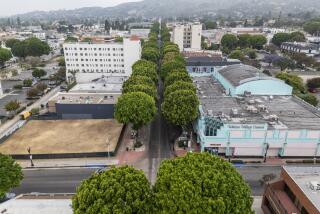SAN JUAN CAPISTRANO : City Closes Deal to Save Open Space
Acting to save historic farmland from development, the city of San Juan Capistrano has paid $6.95 million for 42.3 acres of abandoned citrus groves near the city’s northwestern border.
The announcement, which was made late Tuesday, caps nearly eight months of negotiations with the landowners, members of the Swanner family, who have held the land since the early 1900s. The property includes a historic farmhouse and a Christmas tree farm.
The purchase is the second major land deal undertaken by the city using funds from a $21-million bond measure approved by city voters in April of 1990. Coupled with the 56 acres of farmland at the southern end of the Capistrano Valley bought from the Kinoshita family a year ago, the city now owns nearly 100 acres of farmland that could otherwise have been lost to development.
City Councilman Gary L. Hausdorfer, who is credited with originating the idea of the open-space bond measure, called the latest acquisition “an extremely important step in retaining the rural feeling of San Juan Capistrano” because of the land’s highly visible location along Interstate 5 at the city’s entrance.
“The significance of this acquisition is that it will preserve the view corridor that everyone has when entering the city from the north,” Hausdorfer said. “It . . . creates in perpetuity the open feeling that is the sign of the entrance to San Juan Capistrano.”
The purchase price, which is about $164,000 an acre, was described as fair by Mayor Kenneth E. Friess.
“I think it was a pretty equitable deal for everybody, considering the family probably bought it for $25 an acre,” Friess said. “This is prime property, with access and commercial potential. Commercial property normally runs for . . . $400,000 to $1 million an acre, depending on location.”
The purchase is another step in a larger plan by city officials to buy 140 acres of farmland in both the northern and southern ends of the valley. Once the land is purchased, it will be preserved as open space or used for active recreational facilities, Hausdorfer said.
The Swanner farmland, which sits next to Camino Capistrano about 2 miles north of Mission San Juan Capistrano, is important because of its accessibility and historical significance, said Mark Clancey, president of the Friends of Historic San Juan Capistrano, a local preservationist group.
“This is probably the key acquisition to the whole northwest site,” Clancey said. “It is the most prominent part because it’s along the scenic corridor and it also contains two of the three most important historic farm residences in the Capistrano Valley.”
The Swanner farmhouses were built in the early 1920s by John L. Swanner, said his son, John L. Swanner Jr., 70, by phone from Wichita Falls, Tex. The homes and the surrounding property were inherited from his father’s uncle, R.Y. Williams, a former Orange County Superior Court judge, Swanner said.
Swanner, who said he continues to visit the farm several times a year, only parted with it reluctantly.
“I don’t like losing it, but the city was going to take it anyway,” Swanner said. “But we enjoyed it for years.”
The purchase agreement was broken down into two separate transactions, according to city documents. The larger deal includes the purchase of 38.64 acres of ranchland for $5.99 million, of which $5 million will be paid in cash.
The smaller acquisition calls for the $957,000 cash purchase of the Swanner residence and the tree farm, a total of about 3.63 acres.
More to Read
Sign up for Essential California
The most important California stories and recommendations in your inbox every morning.
You may occasionally receive promotional content from the Los Angeles Times.










